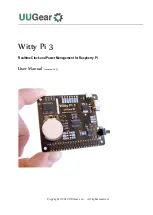
4 – 58
Remote Operation
in the value of the underlying condition register. Transition
register names end with
PT
or
NT
.
Event Registers : These read-only registers record the occurrence of defined
events within the controller. If the event occurs, the corre-
sponding bit is set to 1. Upon querying an event register, any
set bits within it are cleared. These are sometimes known as
“sticky bits,” since once set, a bit can only be cleared by reading
its value. Event register names end with
SR
or
EV
.
Enable Registers : These read
/
write registers define a bitwise mask for their cor-
responding event register. If any bit position is set in an event
register while the same bit position is also set in the enable
register, then the corresponding summary bit message is set in
the Status Byte. Enable register names end with
SE
or
EN
.
Status Byte : This read-only register represents the top of the status model,
and is populated with summary bit messages and interface
condition bits. Enabled bits within the Status Byte generate the
IEEE-488 Request Service event over GPIB.
At power-on, all status registers are cleared.
4.6.1
Status byte (SB)
The Status Byte is the top-level summary of the LDC500 status model.
When masked by the Service Request Enable register, a bit set in the
Status Byte causes a GPIB Request Service event.
Weight
Bit
Flag
1
0
TESB
2
1
LDSB
4
2
undef (0)
8
3
IDLE
16
4
MAV
32
5
ESB
64
6
MSS
128
7
undef (0)
TESB : TEC Controller Event Summary Bit. Indicates whether one or
more of the enabled flags in the TEC Controller Event Register
(
TEEV
) has become true.
LDSB : Laser Diode Event Summary Bit. Indicates whether one or
more of the enabled flags in the Laser Diode Event Register
(
LDEV
) has become true.
IDLE : Indicates that the input bu
ff
er is empty and the command
parser is idle. Can be used to help synchronize LDC500 query
responses.
LDC500 Series Laser Diode Controllers
















































